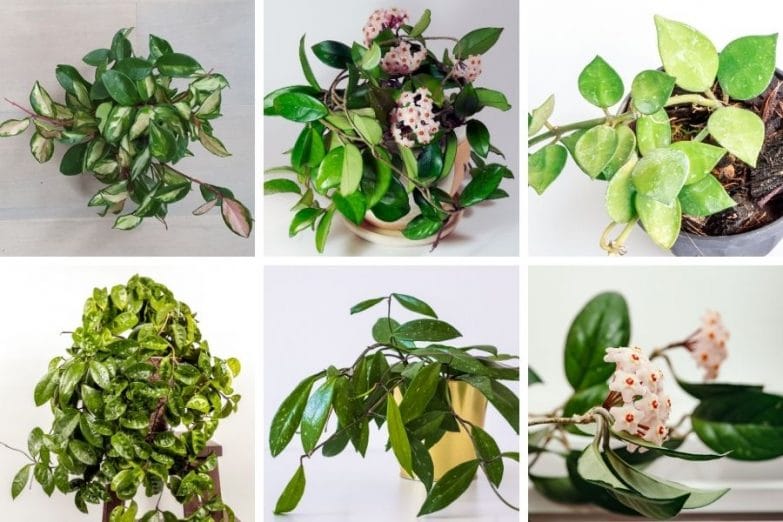Hoyas are a wonderfully strange, beautiful, and numerous plant genus that’s gaining many fans. Besides their amazing flowers, foliage, and fragrance – and despite their reputation for being difficult – many Hoya varieties make excellent beginner plants. No matter how experienced you are as a gardener, you’re certain to be surprised and intrigued by some of these beautiful Hoya varieties.
Hoyas are a diverse plant genus that produces fragrant, star-shaped flowers. Some are easier than others, but all need well-draining soil, warmth, and indirect light. The Eriostemma subgroup prefers strong light and soil that dries between waterings; some Hoyas need cooler night temperatures to bloom.
Hoya Overview
Often sold as Wax Plants, Hoyas are loved for their scented flowers and radiant foliage. Many fans appreciate their stiff, sculptural profile. The countless Hoya varieties just add to the joy.
The expansive genus is native to Asia and Australia, where many grow epiphytically in trees. Most are vines, but a few have bush-like growth. One popular subset of Hoyas need cooler temperatures to bloom.
Hoya flowers are five-pointed stars that come in many shapes, sizes, and red-toned colors. They can be glossy or matte; many are “fat” and some are fuzzy. Even the buds are beautiful: they swell and change in the process of going from bud to bloom.
Hoya Care
Hoyas have an unfortunate image of being difficult to maintain, but only some Hoya varieties really deserve it. Success often boils down to whether you can supply high humidity and properly monitor soil moisture.
There are variations … some Hoyas like bright light, some partial shade; some species thrive on consistent moisture, others need time to dry out.
Because of this diversity, there isn’t one universal care regimen for all Hoyas. It’s important to find out the specific demands of your variety.
- Prune carefully! New flowers develop from old flowering spurs—if you trim these, there won’t be blooms.
- Though often described as low-light plants, most Hoyas actually like a lot of (indirect) light. If you have a hanging plant, make sure there’s enough light on top so it doesn’t go bald.
- Hoyas love bright windows … pull them a few feet away from the glass in hot, direct sun. If the exposure is weak, add grow lights.
Growing Tips
- Let excess water run through the soil at watering time. This fully saturates the soil and helps flush out residual fertilizer and other contaminants.
- Temperatures between 60ºF (15ºC) and 85ºF (30ºC) suit most Hoyas. They aren’t typically frost-tolerant, though there are exceptions. Hoyas that come from high altitudes prefer evening temps to drop as low as 50ºF.
Note: Temperature and watering are important for flowering, and some varieties need a winter’s temperature fluctuation to bloom. If you’re having trouble getting flowers, try giving your Hoya a cool spot and cut back on watering over the winter.
- Even Hoya species that don’t require high humidity will grow faster with it. Semi-succulent varieties can adapt to lower levels, but thin-leaved varieties can be very difficult if they don’t have 60% humidity or more.
- Hoyas aren’t usually big feeders, so feed lightly. Apply a general-purpose liquid houseplant fertilizer at half strength once a month during the spring and summer … or feed every two weeks with an organic fertilizer like worm castings or fish emulsion. Consider bumping up the phosphorus percentage to promote blooming.
- Pests aren’t usually a big issue for healthy Hoyas. Mealybugs and aphids are the most common guests.
Collecting Hoyas
Hoyas are a wonderful plant group to collect because it contains so many unique forms.
Official names of different Hoya varieties are in a continual process of change as botanists advance their understanding. It keeps growers and retailers on their toes.
A group of former Hoyas is called Eriostemma; Hoya is now their official synonym. An Eriostemma’s main distinguishing characteristic is short, soft hairs covering its stems and leaves. As ground plants that twine up trees to live aloft, this group is probably the most difficult to keep happy in a container.
- Hoyas don’t put on new growth until their root system is developed, which is why keeping them in rootbound in small pots helps maximize production. Move the plant to a larger pot after it has put on significant size.
- Some types of Hoya produce nectar during flowering. Nectar is a nice word for a dripping, viscous goo that can damage fabric and furniture – protect your valuables!
- The stem’s growing tip can easily be damaged: heat, intense light, underwatering, or even simple handling can injure the fragile tissue. Damaged tips stop growing and dry up, so handle carefully.
50 Beautiful Hoya Varieties You Will Love
The 50 Hoya varieties on our list are ranked in approximate order of availability and cost. It’s not ordered by the difficulty of growing: some of the most desirable and expensive species make fine beginner plants.
This list reflects a US perspective. Availability varies according to location.
Care tips are included, but these aren’t comprehensive. Research the care needed for your specific plant.
If you’re just starting with Hoyas, don’t be discouraged by species priced beyond your budget. The market fluctuates: it may be economical by the time you’re ready for it.
If you’d like to get some of these stunning Hoyas, buying online is an excellent option. Hoyas ship very well and the variety available online is much better than anything I can find locally. Click here to see the beautiful selection of Hoyas available from Etsy.
1. Hoya Carnosa (Porcelain Flower, Wax Plant)
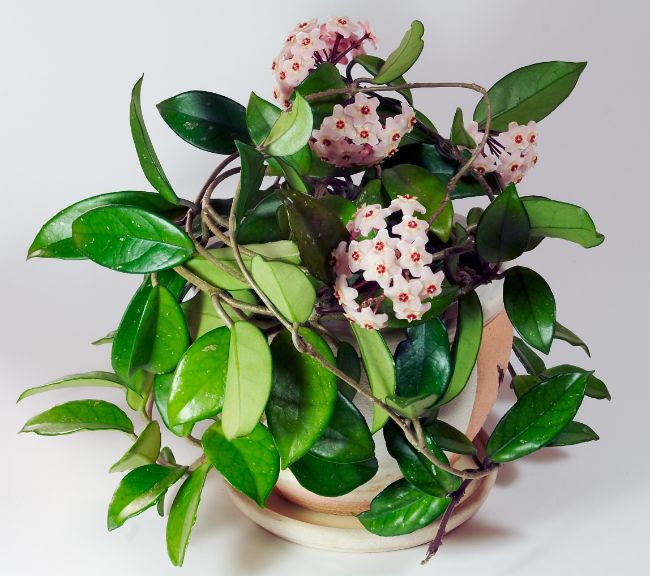
The basic (green) form of Hoya Carnosa is less common than many of its excellent hybrids (of which there are a ridiculous number). The foliage can be plain, variegated, crinkled, or otherwise textured. The blooms are long-lasting, fuzzy clusters of fragrant stars.
Hoya carnosa are hardy, versatile, and easy to live with: they adapt to moderate humidity and light better than most Hoyas. They’re equally happy climbing a trellis or cascading from a hanging basket.
The Carnosa has been cultivated since its discovery in 1770; there are dozens, maybe hundred of cultivars. These include some of the hottest houseplants currently on the market:
- ‘Argentea Princess’
- ‘Chelsea’
- ‘Compacta’ (Indian Rope)
- ‘Exotica’
- ‘Grey Ghost’
- ‘Krimson Princess’
- ‘Krimson Queen’
- ‘Tri-Color’
- ‘Wilbur Graves’
This all-star is great for beginners, and it might reveal if you’re a prospective Hoya fan. Carnosa hybrids are found everywhere Hoyas are sold, but beware: the plant has launched countless plant addictions. I’ve written a guide to caring for Hoya carnosa, which should get you up to speed with the main aspects of Hoya care.
2. Hoya Pubicalyx
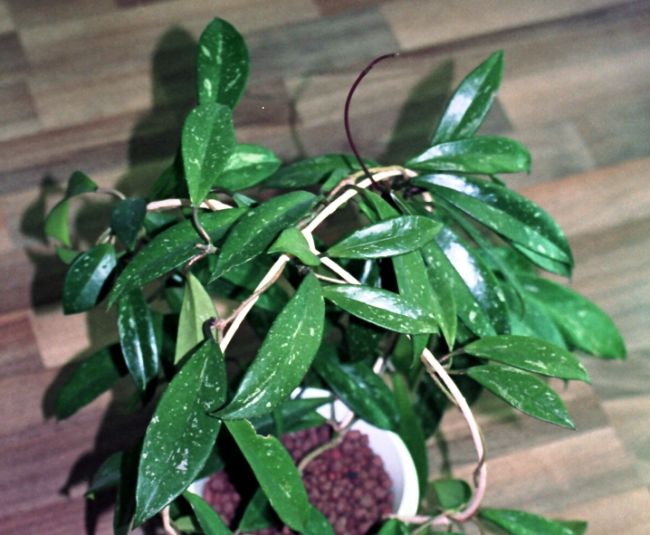
One of Hoyas’s charms is that inexpensive, common varieties can be as gorgeous and interesting as rare, expensive ones. Such is the case with Hoya pubicalyx, an easy-to-grow Hoya that blooms in clusters of up to 30 small, fuzzy flowers. Its crisp, ovoid leaves splay out from vines that grow up to eight feet long. The fragrant flowers last up to 14 days.
Pubicalyx is a hardy twining vine that can trail or climb, but it’s a little unruly: you may spend time unwinding the plant from its neighbors. It’s one of the fastest-growing Hoyas and very easy to propagate – just put a cutting in water.
Hoya pubicalyx is inexpensive and easy to find locally and online. There are cultivars with flower colors from black to deep red to light pink. One of the most sought-after is the ‘Pink Silver’ hybrid flecked with white variegation.
3. Hoya Kentiana
Hoya kentiana is kept for its foliage as much as for its blooms. This buoyant plant fills a pot with a bustling crop of long, lance-shaped leaves. Its sculptural foliage has a waxy surface and attractive dark edges. The clusters of cute, fat little flowers last about a week and smell sweetly of butterscotch.
Hoya kentiana isn’t a finicky plant and can adapt to moderate humidity. Aim for at least 40%, using some of these ways to increase humidity if needed. It likes bright light which can include gentle sun. Give them rocky or barky soil and be careful not to overwater.
This plant looks better the bigger it gets and makes a stunning hanging basket. Hoya kentiana has started showing up in garden centers recently and isn’t pricey or hard to find. There are many attractive hybrids with different colors and variegation patterns.
4. Hoya Kerrii
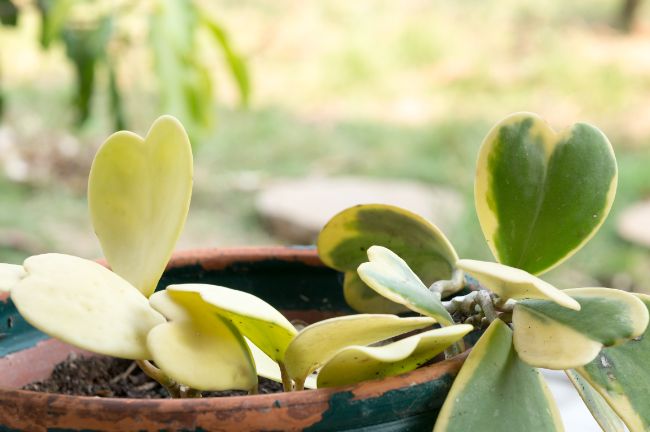
This plant, otherwise known as a Sweetheart Hoya or Lucky Heart, is commonly sold as a single, heart-shaped leaf planted in a small pot. The bright emerald green color of the cute, rounded leaves makes them popular St. Valentine’s Day gifts.
The leaves are thick and almost succulent, and grow about two and a half inches wide. Its climbing vines can reach over twelve feet long.
Hoya kerrii is easy to maintain and can grow briskly once acclimated. It does like stronger light than many varieties – up to 70-90% of full sun. It likes very fast-draining soil.
Many people who buy a Sweetheart Hoya leaf don’t realize it is a leaf cutting and not a full plant. If you buy the plant as a leaf, expect a long waiting period for further development … but it can happen. As long as a stem node was included in the cutting, your leaf may grow into a plant.
5. Hoya Lacunosa (Cinnamon Hoya)
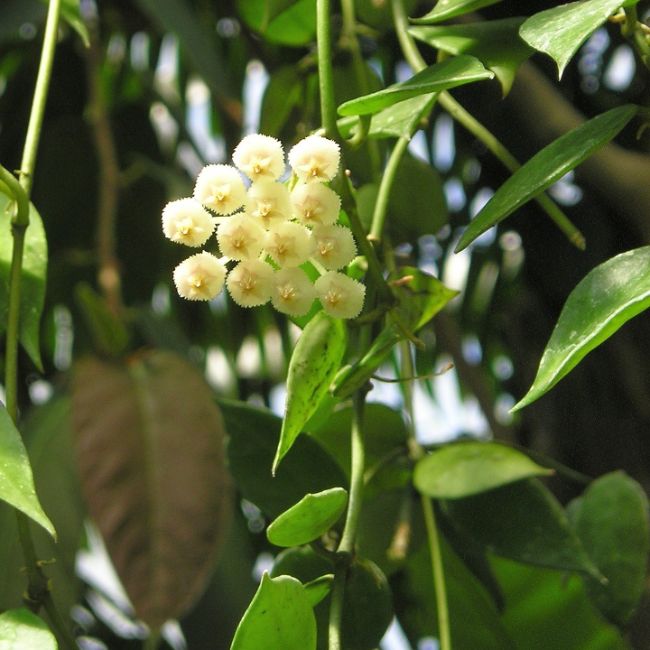
Another fun entry-level Hoya, this is the first plant on our list prized mainly for its fragrance. The plant’s tiny, fuzzy blooms have a cinnamon-scented fragrance that fills their space. Sets of leaves grow along pliable stems; the small, canoe-shaped foliage is waxy and outlined with refined dark edges.
Hoya lacunosa makes an excellent low-maintenance houseplant. It’s a cool-weather Hoya that likes a very airy mix. The plant can reach over five feet tall; as long as the soil isn’t kept too damp, watering it more frequently can stimulate faster growth.
This fragrant variety is a great introduction to highly scented Hoyas. It’s common and is often available for a reasonable cost in garden centers. The original Hoya lacunosa has parented many successful hybrids, too. Speaking of scented plants, I’ve covered some other wonderfully fragrant houseplants in this article.
6. Hoya Australis
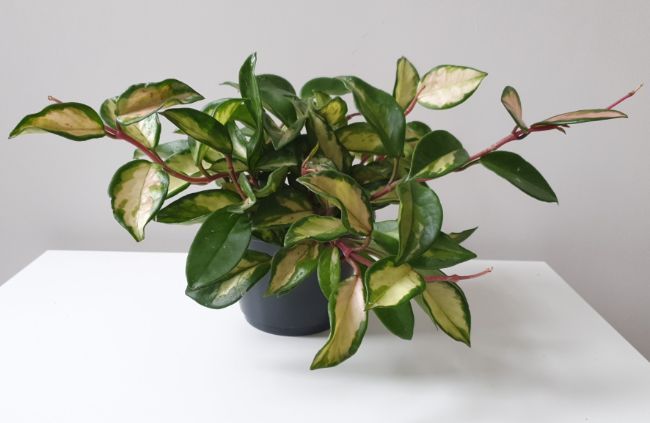
Known commonly as Waxvine or Waxflower, this popular and easy-going Hoya has long climbing stems and broad glossy leaves. The flowers are white with red accents and produce a strong, pleasantly spicy fragrance.
The evergreen vines of this hardy Australian native can reach up to 30 feet long. They enjoy strong indirect light: leaves in brighter conditions take on a gold tint. The foliage darkens in a lower-light setting.
Hoya australis is a great all-around flowering vine that’s been in cultivation for a long time and has many hybrids. Some favorites are the Australis ‘Lisa,’ ‘Rupicola,’ and ‘Variegata.’ You can read my article about growing Hoya australis for more info. You can also buy Hoya australis online and have it shipped directly to your door.
7. Hoya Obovata
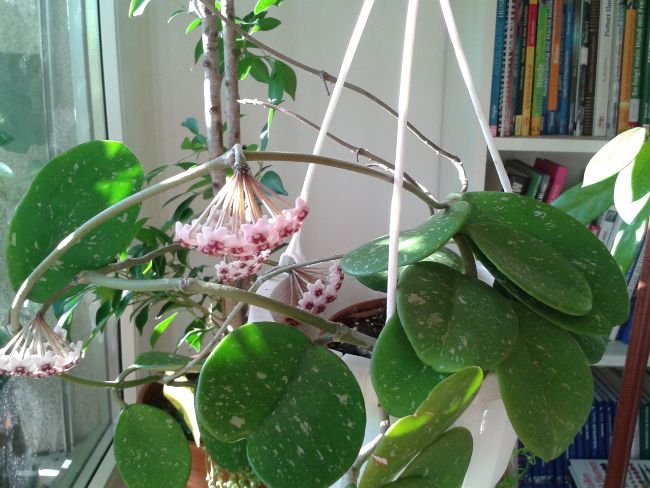
This well-loved variety features large, distinctive saucer-shaped leaves. Its vines form a bushy tangle of overlapping foliage. Some varieties have pink or silver variegation flecks scattered over the dark green leaves.
Hoya obovata’s lovely star-shaped blooms are white to pale purple with pink or red centers. The plant turns lighter in higher light.
While this isn’t the absolute easiest Hoya, beginner’s can have success with careful attention to watering. The plant likes humidity but tolerates average conditions and generally isn’t finicky.
This high-personality plant is very popular and widely available. It’s a wonderful second Hoya for a novice. They are prolific and easy to propagate.
8. Hoya Retusa
This popular little oddity hails from the stranger side of the Hoya spectrum. It features slim, flat, stick-like green foliage splaying out from the soil. The end of each leaf looks as if it were chopped off.
The Hoya retusa produces a scattered crop of chubby, white flowers with maroon pop-out centers … but it can be a challenge to bloom. These are cool-weather plants that need lower night temperatures to trigger flowering.
This unusual variety diversifies your collection and gives you a chance to experience less common forms of Hoya. Hoya retusa may not seem appealing at first glance, but their charm and character can grow on you. It’s an in-person plant.
9. Hoya Bella (Hoya Lanceolata Spp. Bella)
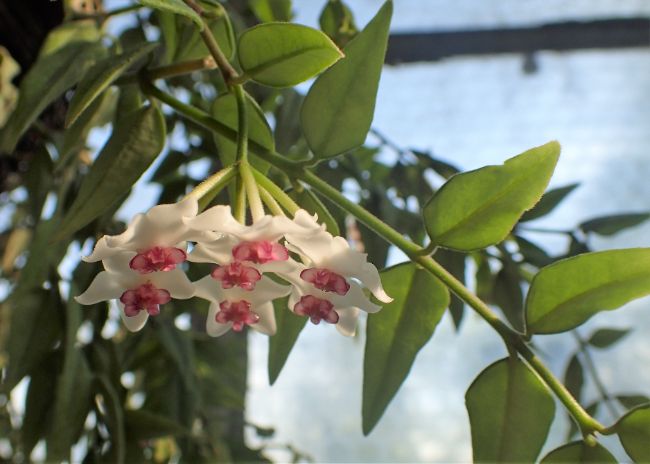
This elegant foliage plant has pointed elliptical leaves deeply indented along the center vein. Its blooms are another highlight: the star-shaped clusters of adorable fat, white flowers have a delicate red to pink coloration.
Hoya bella is the most demanding Hoya we’ve met so far. It’s an epiphyte that needs light, barky substrate; the soil should dry slightly but never completely. Colder nights down to 50ºF (10ºC) and moderate light are preferred. Watch for mite and thrip infestations.
This formerly exorbitant Hoya’s popularity has finally increased production enough to lower prices and make it available. You can buy Hoya Bella from Etsy and have it shipped directly. It’s a rewarding specimen and a good step up to more challenging Hoyas.
10. Hoya Wayetii
A popular variety with draping stems of cascading, canoe-shaped foliage. Its leaves are similar to the Kentiana, but Hoya wayetii’s foliage is shorter and more rounded. It blooms in clusters of attractive plump flowers.
One of the more hardy Hoya varieties, Hoya wayetii likes higher humidity and will pucker if under (or over) watered. It needs a super well-draining mix to keep its epiphytic roots oxygenated (Read my guide to houseplant soil for more information). Give them substantial indirect light to maintain the leaf edge variegation.
A great beginner’s Hoya, the mature Wayetii makes a hanging basket into a showpiece. There’s no shortage of Hoya wayetii hybrids to choose from … the variegated cultivars are especially in demand.
11. Hoya Caudata
The mesmerizing green, semi-succulent foliage of this maverick species is variegated with light-colored splotches over long, oval leaves. Silvery blotches and flecks mark the leaves randomly in vibrant patterns. The attractive blooms are clusters of white fuzzy stars with red centers.
The plant isn’t finicky, but it does want humidity above 50% and consistent soil moisture … the trick is to find the sweet spot. They don’t like intense illumination, and it will need extra time to acclimate after relocation.
There are several popular hybrids including the Sumatra, Borneo, Silver, and Big Green. Hoya caudata isn’t a common garden center plant, but it’s easy to locate online.
Note: We’re leaving the common retail varieties behind! The following Hoyas are usually sourced online through collectors and specialty growers.
12. Hoya Macrophylla
This large, rambling species is prized most especially for its waxy, light green, vein-patterned foliage. Their pointed oval leaves have an interesting 3-D texture. Prominent pale veins run longitudinally across a network of horizontally laid smaller veins.
The flowers are small and dainty, but their color is subdued. The blooms are outshone by the eye-catching leaves, which can grow to five inches long. The plant tops out at about five feet in height with climbing support—it needs space or will have to be cut back significantly.
This easy Hoya likes strong indirect light and humidity of at least 60%. It benefits from a bit of crushed egg or oyster shell mixed into the soil. An eastern exposure with many hours of consistent indirect sun is an ideal location.
Hoya macrophylla is occasionally offered at garden centers and isn’t too pricey. Hybrids with colored leaf margins are usually the most popular and widely available.
13. Hoya Shepherdii
This hardy species is commonly called the Stringbean Hoya for its long, semi-succulent, ribbon-like leaves. Their large, fragrant flowers are white with a red core and have a pristine, starlike bloom in the center.
Normal Hoya care is required. Hoya shepherdii blooms easily (for some), and likes a cool indoor range from 50°F (10°C) and 77°F (25°C). The plant needs well-draining soil and prefers to dry briefly between waterings; it’s rather slow-growing and adapts to average humidity.
Hoya shepherdii’s slender foliage adds diversity to a Hoya collection and looks stunning in a hanging basket—the blooms are a bonus. It isn’t a hard variety to source, just don’t confuse it with another strap-leaved species like the Wayetii or Kentiana.
14. Hoya Memoria (Gracilis)
This clean-cut vine features elegant, bright-green, elongated oval leaves with a waxy finish and a light speckling of variegation. New foliage emerges with red hues. They bloom in pink flowers with red and yellow centers that exude the sweet scent of caramel.
This is an easy-going variety that a conscientious novice can succeed with. It’s prolific under normal Hoya care. Hoya memoria doesn’t twine but can climb with attachment support and also makes a wonderful hanging plant. It flowers almost continuously under good conditions.
This is a Hoya species that was sold as a Hoya gracilis for years, and sometimes it still is. Formally described in 2004 and renamed, Hoya memoria’s availability varies by location … but a cutting is usually available for a reasonable price.
15. Hoya Neocaledonica
A sweet vining Hoya that blooms well and is perfectly sized for container living. The rounded foliage is a cheerful lemon-green shade. The plant produces yellow flowers with pink to cherry red centers.
This is an easy Hoya to care for. Normal care tips apply, but this plant could happily belong to a beginner’s collection if it were more widely available.
Hoya neocaledonica is a hardy variety that’s less common than it should be, so it might take extra effort to track down. It’s a worthwhile and simple Hoya that needs your love.
16. Hoya Fitchii
This gorgeous vining plant features a pale, finely webbed vein pattern over emerald leaves – but that’s not all. The Hoya fitchii also produces copper-colored blooms with vibrant coral-pink centers. The colors are influenced by growing conditions and can vary from yellow to orange to pink.
This is one of the easier Hoya varieties, though it’s typically slow-growing. It does better in higher humidity and can struggle with less than 50%. You can let the soil dry out a bit before rewatering.
Hoya fitchii is popular and in-demand with collectors, but it isn’t in most local garden stores. You can usually find cuttings and small plants online. Prices aren’t cheap but haven’t hit the ozone layer, and hopefully won’t.
17. Hoya Burtoniae
The compact, fuzzy leaves and mid-length vines make this a popular hanging basket plant. Its olive-green foliage reddens in high light; a dark border may be present. The plant blooms easily and produces quantities of raspberry-colored flowers in groups of 15-20 per cluster.
There is more than usual confusion around the Hoya burtoniae’s identity. It has a near-twin called the Hoya Sp. Aff. burtoniae (Sp. Aff. means “Species Affinity”), and it’s also commonly sold as a Bilobata or DS-70, or a cross between them. Exercise caution when purchasing, and remember that the real Hoya burtoniae has fuzzy leaves.
All of these similar species are nice … you might want to consider one of these instead. The trending Sp. Aff. Burtoniae is even hardier and more tolerant than its namesake. Just be sure to know what you’re getting!
18. Hoya Coronaria
This variety will turn your head if you’re an aficionado of fuzzy leaves. The deep green, often glaucous-colored stems and large, paddle-shaped foliage are covered in a soft layer of fuzz – it’s basically a felted plant.
The other outstanding feature of this species is its solid flowers with hardened petals; from the front it looks like an ocean starfish. The blossoms are sizeable at over an inch wide and have reddish-pink speckling and tinting that is affected by their lighting.
Hoya coronaria is an Eriostemma, so it’s not one of the easier Hoyas. It has a squat, low profile with thick central stems that can grow to five feet in length. The leaves are succulent and need less water than some Hoyas, but the plant likes high humidity.
This specialty Hoya isn’t hard to find, and it’s a beautiful and unusual addition to any collection. Its many cultivars include flowers from white to red.
19. Hoya Linearis
This eye-catching radical is a departure from the oval-leaved, vining Hoya of popular imagination. Hoya linearis has long, thin, fuzzy leaves that look like decorative green beans. Blooms come in clusters of white, lemon-scented flowers with yellow- or pink-hued centers.
The Hoya linearis is a cool growing Hoya that prefers lower temperatures at night. It’s a bit demanding. The plant tends to shrivel in less than 50-70% humidity, and must be watered carefully because it’s sensitive to rot.
This up-and-coming star is comparatively new on the market. Growers are slowly catching up with demand, so look for prices to start settling. Cuttings should be available online.
20. Hoya Finlaysonii
Hoya finlaysonii is a designer hybrid with an exotic, upbeat vein pattern. The long, oval foliage is fuzzy and soft. The plant produces globular clusters of white flowers with red center blossoms that look like gummy-bear candy … but the scene-stealing foliage is the main attraction.
Though this isn’t one of the more difficult Hoya varieties, it doesn’t hurt if you have some Hoya experience. It can be a slow grower depending upon your strain.
This excellent Hoya has been around for years without generating much attention, but it’s lately been caught in a collectors’ frenzy. Rooted stems and cuttings are flying everywhere. A short online search should yield results.
21. Hoya Imperialis
This is one of those cute baby plants that grow into monsters. The elongated oval leaves of a small plant are just a few inches long – foliage on a mature specimen reaches over a foot in length.
The oversized red or pink flowers with cream centers blooms are a highlight, too. The variety blooms prolifically in good conditions and is one of the easier Hoyas to flower.
Unlike many Hoya varieties, the Hoya imperialis is a terrestrial plant that wants a more typical soil than the airy mixes used for epiphytes. It likes a lot of light and does well pulled a few feet back from an intense southern or western exposure. Tolerates a range of 60º (15ºC) to 90ºF (32ºC) but slows down below 70ºF (21ºC).
This plant is popular with collectors but isn’t on the general market, so it may take a short search to find. There are several exceptional hybrids, including the ‘Palawan’ with vanilla-colored blooms.
22. Hoya Skinneriana (Hoya ‘Dee’s Big One’)
For years it was thought this plant was a Carnosa hybrid, but after testing it was officially reclassed to Hoya skinneriana. It has robust, vibrant green, oval leaves on rambling vines … but the reason for the plant’s runaway popularity is its blooms.
The plant produces flowers in shades of pink and white that are almost an inch wide, packed in clusters of 20 or more. These form softball-sized puffs of color all over the plant and last for days.
A second reason for this variety’s popularity is how easy it is to keep. One reason this plant was assumed to be a Carnosa for so many years is that it thrives on similar care and makes a great beginner’s plant.
You won’t have trouble finding ‘Dee’s Big One’ online, and you may occasionally spot them in garden centers. It’s a great all-rounder that’s sparked more than one Hoya addiction.
23. Hoya Diversifolia
This trailing Hoya has simple green, oval leaves with deep indentations along the central vein. It produces the classic Hoya flower: a large drooping cluster of star-shaped, fuzzy, waxlike pink-and-white or yellow blooms. The flowers are fragrant and often produce nectar (protect vulnerable furnishings!).
Normal care for an epiphytic Hoya is required, including an airy, fast-draining mix. They prefer strong indirect light or dappled sun. If you are having trouble with blooming, providing more light may help. Provide climbing support.
Hoya diversifolia is an excellent flowering variety that begins blooming early in life and produces steadily through the warm season. It’s not difficult to source online, but some cultivars are more common than others.
24. Hoya Pachyclada
This striking Hoya is an extreme of the succulent type, with fat foliage and thick stems. Its rounded, slightly cupped leaves have prominent veins and are attached to the main trunk by a thick petiole; the leaves grow bigger as the plant grows. The plant blooms profusely with fragrant white flowers.
This is a slow grower and something of a xerophyte (needs little water). Treat this plant more as a succulent than a typical Hoya: give it bright light and let the soil dry before rewatering. Make sure the soil drains quickly so the roots never sit in water.
A Hoya variety that’s been around for years and is sometimes overlooked, the Hoya pachyclada is a great plant for novices. A large specimen looks fantastic cascading from a hanging basket. It may take a search to find, but it’s not rare.
25. Hoya Mindorensis
This champion blooming variety produces ball-shaped clusters of red-hued and white flowers. The plant is straightforward but attractive, with lance-shaped green foliage on vining stems.
This is an ephiphyte, so make sure the soil is chunky and fast-draining. Hoya mindorensis isn’t difficult if you supply good humidity and light. A drop of about 10ºF overnight can aid health and flowering.
Charming flowers like those of Hoya mindorensis are one reason people fall in love with Hoyas. This isn’t a common variety but shouldn’t be hard to find. Prices are very uneven, so you might get a bargain if you shop around.
26. Hoya Multiflora
This distinctive Hoya with a woodland vibe has strong stems, thin leaves, and upright growth. The elongated foliage is deep green. The plant blooms in profuse clusters of narrow, swept-back white petals that gradate to yellow at the ends – the reason it is called the Shooting Star Hoya.
Care guidelines for this thin-leaved variety follows basic Hoya requirements but allows for more frequent watering. The plant tolerates moderate light and average humidity. It blooms prolifically in good conditions.
The Hoya multiflora is an excellent Hoya that should get more attention. It’s a bit uncommon but can be found online.
27. Hoya Affinis
This vibrant Hoya features pale green, paddle-shaped leaves on winding stems. Tiny hairs on the leaves give it a fuzzy appearance. The maroon, mildly musk-scented flower clusters are almost two inches across.
An Eriostemma native to the Solomon Islands, the vines of this warmth-loving climber must grow almost five feet long before it will flower. The plant likes strong indirect light and will stretch for a light source if conditions are dim. It tolerates average humidity.
Hoya affinis is a wonderful flowering variety with classic foliage that makes a fantastic hanging plant. It’s a popular collector’s plant and shouldn’t be hard to obtain.
28. Hoya Sigillatis
A designer’s Hoya, this classic variety features sword-shaped foliage that grows in clumps along small, rambling vines. It’s striking as a hanging plant and has a unique dusty-rose color pallet. Higher light causes redder hues.
The midsized, three-inch long foliage is highly individualistic, but the basic pattern is flat or gray-green leaves with silver mottling. The blooms are a tasteful beige or brown; the flowers look like cookie batter formed and ready for baking. They have a slight caramel fragrance.
As an epiphyte, Hoya sigillatis is prone to root rot and needs well-draining, airy soil. It likes strong light and does well under artificial illumination.
This trendy species is not usually available in garden centers but isn’t hard to track down online. There are several similar varieties of this special Hoya; for example, the Hoya sp. UT-011 has differently colored blooms and completely lacks silver variegation.
29. Hoya Acuta
The Hoya acuta is a low-key climbing vine with rather pedestrian leaves that happens to be one of the easiest and best flowering Hoyas. Each spectacular cluster contains about fifty pink and white small flowers. The lance-shaped foliage grows from short petioles that attach to the main stem.
One of the easier-to-care-for Hoya varieties, the Hoya acuta can tolerate moderate humidity and likes a comfortable indoor temperature range. It grows and blooms well with regular light fertilization every month.
There is a variety with nice silver splash variegation, though it needs adequate light to maintain. Hoya acuta is gaining attention but still isn’t common: the primary means of distribution is a collector’s cutting.
30. Hoya Pauciflora
This unique vining Hoya has thick stems with leaves grouped together at each node. The foliage is long and slender, almost ribbon-like, and pointed at each end. Overall it looks like miniature bamboo.
Hoya pauciflora produces single, fragrant, one-inch-wide white flowers with crimson centers. The fuzzy single flowers are unusual and rewarding, but flowering can be difficult without cool temperatures and a nightly fluctuation – indeed, the name Pauciflora implies “few blooms.”
This is a standout foliage variety, however. It’s easy indoors and grows vigorously. Moderate light is preferred: the plant will turn pale if illumination is too strong.
A large Hoya pauciflora makes a spectacular showpiece. It’s excellent in hanging planters! Availability has been a problem for this plant, but it’s been easier to find recently.
31. Hoya Krohniana
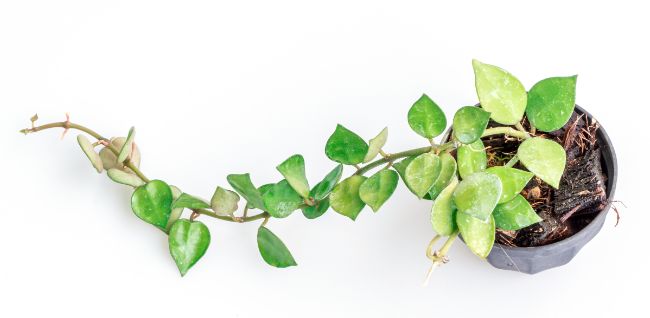
This elegant variety has small, heart-shaped leaves that grow in pairs or small clusters on the long stem vine. It’s a close cousin to the Hoya lacunosa and recently reclassed to its own species (the Hoya krohniana has much larger blooms).
The plant flowers profusely in season with clusters of fragrant, white blooms. The intoxicating scent is heaviest at night.
Hoya krohniana isn’t difficult to keep and grows fairly quickly in favorable conditions. It likes humidity but can adapt to lower levels; plants that struggle with dry air over the winter should recover quickly in the spring. The plant prefers cooler temperatures.
The availability of the species varies, but it’s not hard to locate. Some in-demand cultivars are more expensive than the original, including the ‘Krohniana Silver,’ the ‘Black,’ or the ‘Eskimo,’ which has silver-flecked variegation.
32. Hoya Curtisii
This understated plant is one of the most beautiful compact Hoya varieties. It’s a miniature creeping succulent with small and round, olive-hued foliage mottled with silver and purple flecks. It blooms with cute, fragrant lime-green flowers.
This isn’t a beginner’s Hoya. It never likes to dry completely and stays more compact in bright light. It drops leaves from stress and needs extra acclimation time after a move, repotting or major change in conditions. Once it gets going, it’s a moderate grower.
Hoya curtisii works as a hanging plant or a trailing ground cover. It’s a nice desktop Hoya that won’t outgrow your room. It’s usually not difficult to find this popular plant at a reasonable cost, but prices can vary dramatically.
33. Hoya Odorata
As the name suggests, scent is the big feature of this Philippine Hoya: the plant produces small clusters of white, star-shaped, waxy blooms with an intense, sweet fragrance. The odor is citrusy; it is strongest at night and can be overpowering in small spaces.
The Hoya odorata is a strangely indeterminate plant: part bush, part vine; not really a climber, not quite a pendant-leafed hanger. The foliage is small and pointed and hugs the stem. New leaves emerge with a pinkish hue.
This isn’t a difficult plant; it thrives on normal Hoya care. It’s not a hard variety to bloom, either. Let the soil dry out slightly between waterings.
A favorite of yesteryear, the popularity of the perfumed Hoya odorata has been increasing recently. It’s not a plant you’ll often stumble across at market, but it isn’t rare or exorbitantly priced.
34. Hoya Merrillii
This stunning epiphyte is a beautiful foliage plant with some extras. The oval, pointed, paddle-shaped leaves are a bright, rich avocado color and have a lustrous sheen … its veins are delicately delineated across the top surface.
The foliage becomes red-tinted in strong light, giving the plant a rosy blush. The Hoya merrillii blooms with classic sprays of sweetly scented white or yellow blooms. It does well in a hanging basket or with climbing support.
This isn’t an overly demanding Hoya, but it does appreciate higher humidity. Let it dry out for a short time between waterings to impede fungus and other moisture pathogens.
Garden centers don’t often carry Hoya merrilli, and its availability through collectors varies by location. It was a reasonably priced houseplant that got caught up in the Hoya frenzy and now often carries an outlandish price tag … but they’ll come back to earth someday.
35. Hoya Cumingiana
This lovable Hoya is a potential starlet waiting for the spotlight. Its sturdy, pristine vines and dark green, oval leaves are mildly succulent. The plant is bushy when small and matures into a trailing plant once the vines grow long enough to topple over.
The fragrant flowers are small and white with sweptback petals. The scent is pleasant and spicy. The plant blooms on the ends of its stems: many growers prune the plant to increase branching and eventual flowers.
Hoya cumingiana is a great plant for beginners: it grows briskly and adapts to average humidity and a range of light conditions. It naturally grows in limestone-rich environments, so adding egg or oyster shells to the soil is beneficial.
This plant is popular in Asia but not yet widely cultivated in North America. It’s not hard to find the plant online, but prices fluctuate. Cuttings root easily and are more economical than larger rooted plants.
36. Hoya Brevialata
This cute, compact epiphyte may have the smallest leaves of any Hoya. It emits a Peperomia-like aura as a desk or windowsill plant. The foliage is light green and slightly cupped. It blooms in clusters of cream flowers with red centers that smell like sweet caramel.
The Hoya brevialata is easy to care for, but it can be temperamental about moisture. It’s pretty thirsty and likes high humidity, especially if its soil doesn’t hold enough water. Be careful not to keep the soil too moist, however – remember the plant is a succulent epiphyte.
This is a formerly rare beginner’s plant that’s becoming more popular and easier to find in Europe, but it’s not yet widely available in North America.
37. Hoya Meredithii
The spectacular veining of this vining Hoya reverses the look of many tropicals by featuring dark green veins on a light green background. The broad, plump, oval leaves have wavy edges and are covered in a handsome web pattern. The plant produces delicate, lemon-scented flowers.
This beauty comes with a cost, however – it’s one for more experienced thumbs. Hoya meredithii is a humidity diva that prefers warm temperatures; or rather, demands it. It starts to slow growth if temperatures fall under 70ºF (21ºC). A fast-draining mix and close monitoring are essential.
If you do have success, the Hoya meredithii’s foliage grows larger and more spectacular as it matures. The plant is becoming increasingly available online as more growers discover it.
38. Hoya Latifolia
This impressive variety is known as the Dinner Plate Hoya for its huge, round leaves. It grows on sturdy, fat, climbing stems. Though grown for its large, round leaves, the Hoya latifolia has lovely globular blooms with clusters containing dozens of small flowers.
This plant is suitable for an advanced beginner. The main challenge is managing growth: the plant grows briskly under strong light with warm temperatures. Water when the top inch of soil is dry; brief dry spells are tolerated, but don’t push it!
Hoya latifolia is a unique statement plant that be a showpiece or backdrop a collection, but you’ll need to give it space as it matures. The plant was popular and is regaining attention. Its availability varies; be prepared to spend.
39. Hoya Globulosa
The mesmerizing surface of Hoya globulosa’s pointy, paddle-shaped leaves displays green-on-green veining and handsome indentation patterns. Though it can be a temperamental bloomer, the plant can produce radiant globes of bright, fat white flowers with red centers.
This is a cool-growing Himalayan species that needs high humidity above 60% … and also soil that dries out a bit between waterings. In the winter they do well with less watering and drier soil.
The broad, sculptural leaves of a Hoya globulosa can animate a space. This was a standard-issue Hoya a few years ago until it became highly in-demand. Now it has a formidable price tag and finding one may require a hunt.
40. Hoya Subcalva
The clean, glossy, paddle-shaped leaves of this elegant specimen splay out from thin vines. New foliage emerges pale and darkens to a deep green; each leaf grows to about five inches long.
The long-lasting flowers are notable, too: they bloom in clusters of about 20 raspberry-pink blossoms that smell like grape juice. The petal margins are light apricot, and a wide pink band of color runs along the center vein.
The cost and effort of locating a Hoya subcalva means it probably isn’t a good first Hoya for beginners, but it’s not finicky. It likes humidity of 60% or more and grows steadily during the warm months. Though the plant isn’t a heavy feeder, flowering can be boosted by a modest increase of phosphorus.
Hoya subcalva is a favorite collector’s variety … and why not? The plant hits all the Hoya highlights: attractive leaves, exotic vining growth, and beautiful flowers with an enticing fragrance. The plant isn’t common, but it’s often available online.
41. Hoya Lauterbachii
This Eriostemma, also called the Giant Wax Plant, grows vines long enough to climb trees in its native forest. The deep green foliage is oval with a pointed tip. Its spectacular, extra-wide blooms are pink to crimson.
The scent of these imposing flowers is rather foul, unfortunately, but it’s probably a moot point: Getting a Hoya lauterbachii to bloom indoors is not easy. Besides being a species that requires cooler nights to flower, and species must grow several meters long first.
As diffident as this Hoya species is about flowering, it’s not difficult to keep. The leafy, twining vines are easily trained and wrap gracefully around a support.
Though it isn’t for inexperienced growers, this is a standout species highly prized by collectors. The Hoya lauterbachii is available but isn’t in common circulation.
42. Hoya Callistophylla
This splendid climbing variety features artistic dark markings against the lime-green background of its stiff, tough leaves. The pattern subdivides each leaf’s surface visually into rectangles, giving the foliage a boldly textured, exotic appearance.
Though overshadowed by the foliage, Hoya callistophylla’s blooms are beautiful clusters of red-hued peduncles bearing white flowers. Their fragrance is sweetly perfumed.
Hoya callistophylla is something of a diva about its demands for high humidity and careful watering. Failure to comply is met with stagnant growth and discolored or dying foliage.
This is one of the more showy Hoya varieties and is excellent in hanging baskets or with climbing support. There are several types of Hoya callistophylla, including varieties with short or long leaves. The plant has been spotlit by collectors and prices have soared.
43. Hoya Polyneura
This perky, exclusive Himalayan variety has pairs of narrow, thin leaves with quietly understated dark vein patterns. Paired on vining stems, the leaves together look like a fish’s tail (hence its common name: Fish-tail Hoya).
This wouldn’t be a good candidate for your first Hoya; maybe not even your second. Opinions differ on how easy it is to grow, but many consider it difficult.
Hoya polyneura doesn’t ship well or acclimate easily: they are prone to turning yellow and disintegrating after a move. It needs humidity and consistent moisture – it won’t like overwatering or underwatering one bit. The leaf lightens with yellow highlights in brighter light.
Hoya polyneura is a trendy and expensive Hoya that’s not difficult to come by. There’s also a rarer variegated version.
44. Hoya Undulata
Not to put you off, but this Hoya could probably pass as a (very nice) weed. Its broad and wavy-edged leaves look tattered and worn even when perfectly sound, as if fashionably “distressed” to appear aged and rugged. The leaves turn vibrant red under excess light.
Hoya undulata is an epiphyte that grows in birds’ nest fashion and recalls a loose-leafed lettuce plant gone to seed. It flowers with classic Hoya clusters: the exquisite, shiny blooms are white with a rosy blush and crimson speckling. The flowers smell like grape juice.
This isn’t an easy plant to maintain and even more difficult to make flower. It likes a lot of heat and needs to dry out between waterings. The plant is rare and specific care requirements are still being determined.
Hoya undulata offers rather un-Hoya-like beauty in a unique plant. If you’re looking for a challenge, this Hoya is a fine reward. It’s pricey and hard to locate.
45. Hoya Serpens
This cute Hoya’s trailing stems are lined with pairs of small, rounded leaves. The tumbling foliage is distinctive and charming. The lovely white flowers have red or pink centers; unfortunately, it can be a challenge to convince the plant to bloom.
Hoya serpens likes being outdoors but comes from the Himalayan region and needs cooler temperatures – this isn’t a plant most of us can keep outside all summer. It isn’t too difficult to maintain the plant with typical Hoya care, but you may want to get some easier specimens under your belt first.
The cascading round leaves may seem irresistible, but wait until you see the price tag. This popular but hard-to-find Hoya sits on many growers’ wish lists, so you may be in for a search.
46. Hoya Imbricata
This is one of the strangest types of Hoya, so sit down. In nature, this plant often presents as a series of lily pads stacked vertically up a tree. The round leaves cling to an available surface or curl in the air without support.
The purpose of the leaf pattern is to provide a covered space tunnel for ants to travel beneath safely, and thereby protect the plant. It’s an amazing symbiotic relationship.
It’s quite an attractive vine – cute round leaves, lovely green color – it just happens to be stuck flat up against the side of a tree or rock … or mounting board. The leaves can grow up to 10 inches wide on some varieties and are a lovely mottled green.
Hoya imbricata requires high humidity, warmth, and diffuse bright light. They do well in dappled shade outdoors; it’s hard to give them enough light indoors without putting them in direct sun. Some growers add artificial lighting.
This fascinating plant is best left to experienced Hoya owners. The Hoya imbricata has been gaining popularity and will take an effort to track down.
47. Hoya Elliptica
One of the nicest prominently veined Hoya varieties, the Hoya elliptica’s pale markings visually divide each kelly-green leaf into quadrants. Each leaf resembles a turtle shell: hence the common name, Turtle Shell Hoya.
The plant blooms in stunning clusters of small, showy flowers. The fat outer petals are a fuzzy backdrop to the discrete inner blooms which look like star-shaped gummy bears. The centers are red or pink. The flowers’ scent has been described as that of fresh bread dough.
Hoya elliptica needs a grower with experience. It likes higher temperatures and humidity, and strong indirect light. The species is subject to shipping stress and doesn’t like to be moved, so let the plant acclimate after relocation. It’s a steady grower under the right conditions.
This plant used to be out of reach of average hobbyists, but its popularity is driving increased production and lower prices. You should be able to find cuttings on line.
48. Hoya Megalaster
The handsome and distinctive texture of this vine’s dark foliage would look right at home in a primordial jungle. It blooms prolifically in the right conditions, producing large, short-lived, pink or red flowers with a vanilla fragrance. Healthy plants can bloom almost continuously.
Hoya megalaster isn’t difficult if it has adequate heat and humidity. They like stronger indirect light than most Hoya varieties and are generally modest growers. Young plants do well in terrariums, though they’ll outgrow most setups.
A mature specimen is an incredibly stunning tropical plant – Megalasters grow up to five feet tall. High demand makes this plant a bit of an adventure to acquire.
49. Hoya Spartioides
This unforgettable variety is an even higher-end collection of stalks than the trendy Retusa. Hoya spartioides has either dispensed with its peduncles or merged with them – the plant is essentially leafless and is composed instead of long, whiplike, green peduncles that flower from their ends. The smallish, colorful, hanging blooms last only a day.
The plant thrives on normal Hoya care … with a few twists. Hoya spartioides can adapt to average humidity of about 50% but likes strong indirect light (since it has no leaves!). Keep the soil slightly moist and avoid letting it go completely dry between waterings.
Hoya spartioides is a notable oddity many collectors seek out … it stretches the definition of what we call a “plant.” The species is in high demand and rather rare.
50. Hoya Macgillivrayi
The plant’s scale and elegance make it one of the finest Hoya varieties. It is a giant vining plant that produces a profusion of glossy, dark green foliage. The classic paddle-shaped leaves are large and robust. New leaves emerge with a reddish/bronze color and darken as they mature.
Hoya macgillivrayi is a champion bloomer, too. Its clusters of star-shaped, burgundy flowers are over two inches wide and unfold in a refined origami style. Their scent is sweet and evocative and is most potent at night.
Related Articles
I hope you’ve enjoyed this beautiful selection of Hoya varieties. My house is filling up with more and more of these wonderful plants, and I just can’t resist adding to my collection. If you’d like to read more, I’ve listed some other articles that you might be interested in below.

